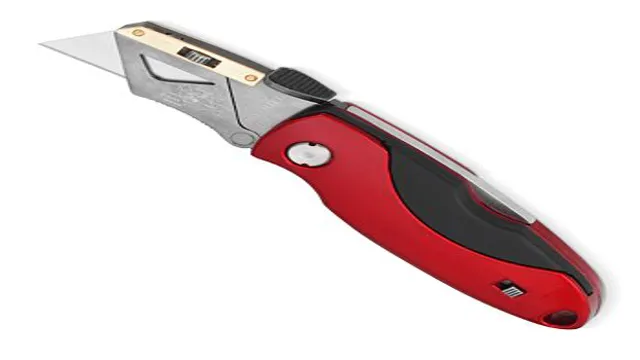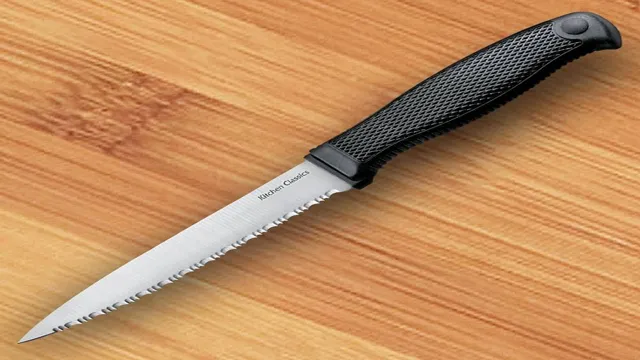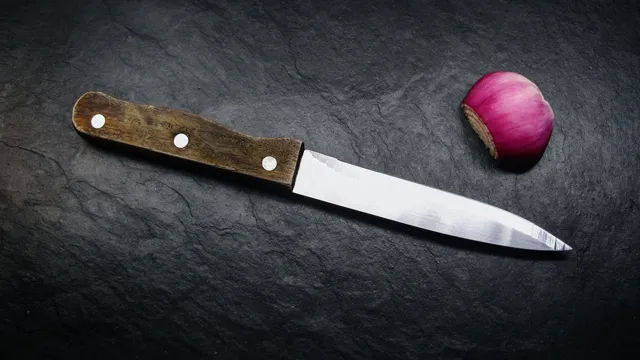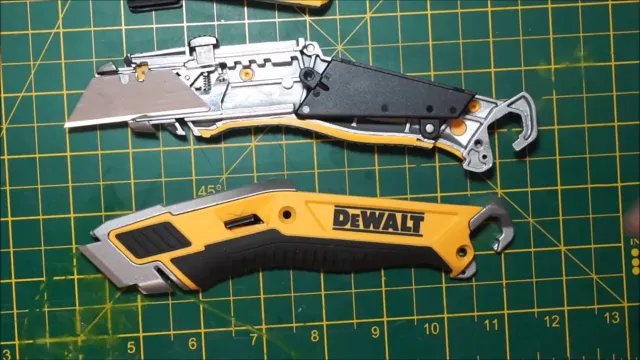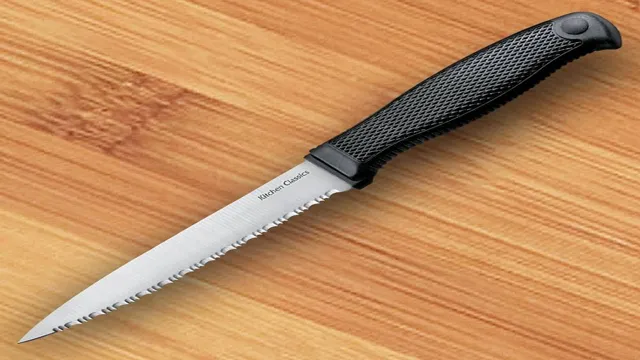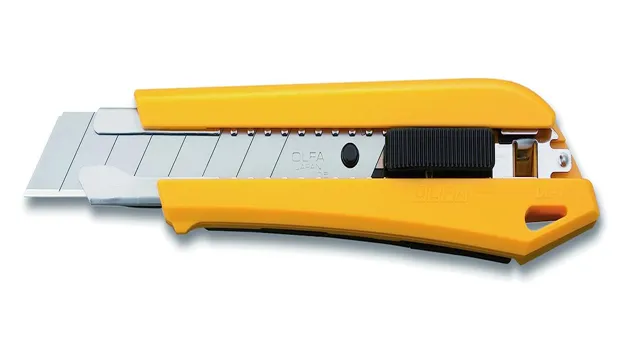What is a Kitchen Serrated Utility Knife Used For? A Guide to Cutting and Chopping with Precision
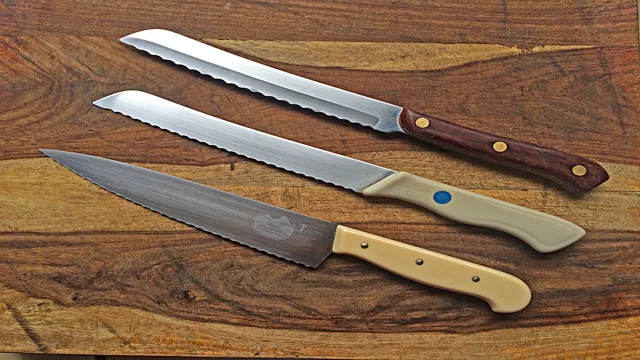
If you spend a lot of time in the kitchen, it’s important to have the right tools at your disposal. One tool that might not be on your radar just yet is a serrated utility knife. What is a serrated utility knife, you might be wondering? Well, it’s a versatile kitchen knife that can be used for a wide range of tasks.
Unlike a traditional chef’s knife or paring knife, a serrated utility knife features a jagged edge that helps to grip and cut through tougher foods with ease. Think crusty loaves of bread, thick-skinned fruits like tomatoes, and even meat. But beyond its functionality, a serrated utility knife is also a great addition to your kitchen because of its durability.
With proper care and maintenance, a good serrated utility knife can last for years. And let’s be real, there’s nothing quite like the satisfaction of using a well-crafted tool to tackle a kitchen task. Whether you’re a professional chef or just someone who enjoys cooking at home, a serrated utility knife is definitely worth considering.
In fact, you might wonder how you ever managed without one once you start using it. So go ahead, give it a try, and see for yourself why a serrated utility knife is a must-have kitchen tool.
Overview of Kitchen Knives
A kitchen serrated utility knife, also known as a tomato knife or sandwich knife, is commonly used for slicing soft foods that have tough exteriors, such as tomatoes, bread, and citrus fruits. The serrated blade on this type of knife allows for clean and effortless slicing without damaging the delicate interior of the food. The pointed tip of the utility knife can also be used for removing stems or cutting small incisions.
While this knife can be versatile in its use, it is not recommended for chopping or heavy-duty cutting tasks. Ensure that you choose a high-quality serrated utility knife with a comfortable handle to make it easier to maneuver while cutting through tough foods such as crusty bread or juicy tomatoes. A sharp and well-maintained knife will not only make cooking more enjoyable but also ensure that your food is sliced cleanly and efficiently.
Different Types of Kitchen Knives
Kitchen Knives When it comes to cooking, having the right set of kitchen knives is essential for any home cook or professional chef. Various types of kitchen knives are available for specific functions, including slicing, chopping, and dicing. The most common knife found in kitchens is the Chef’s knife, which is typically an all-purpose knife used for chopping vegetables, meat, and fruit.
Another popular knife is the Bread Knife, famous for slicing through tough crusts while keeping the bread’s soft interior intact. Additionally, Santoku knives are Japanese knives similar to the Chef’s knife but have unique characteristics and often used for slicing, dicing, and mincing. For preparing fish, a Fillet Knife is the best choice due to its flexible blade and sharper edge that allows for precise cuts.
Paring knives are smaller in size, perfect for peeling vegetables or fruits, and the small blade makes it easier to control. Lastly, a Cleaver Knife is a heavy-duty tool often used to cut through dense meats or bones. Understanding the various types of kitchen knives can help any cook select the right tool for the job and elevate culinary skills in the kitchen.

What is a Serrated Utility Knife?
A serrated utility knife is a type of kitchen knife that is versatile and has a serrated edge. It usually has a blade length of 4 to 7 inches and can be used for a variety of tasks. The serrated edge of the knife is designed to cut through tough materials, such as meat and vegetables with tough skins.
This type of knife is ideal for slicing bread and cutting through foods with soft interiors and hard exteriors, such as tomatoes or pineapples. The serrations on the blade help prevent the knife from slipping, making it easy to cut through tough materials. When choosing a serrated utility knife, look for one with a comfortable handle and a sharp, serrated edge.
With the right knife, you’ll be able to take on any kitchen task with ease!
Serrated Utility Knife vs Plain-Edged Utility Knife
When it comes to equipping your kitchen with the right knives, it’s essential to understand the difference between a serrated utility knife and a plain-edged utility knife. A serrated utility knife is perfect for slicing through hard and crusty foods, as its teeth grip the surface and make it easier to cut through. On the other hand, a plain-edge utility knife is more versatile, cutting through soft, delicate foods with ease, and allowing for more precise cuts.
While a serrated utility knife may be perfect for bread and tomatoes, a plain-edged utility knife is better suited for tasks like slicing meat and vegetables. Therefore, it’s crucial to understand the tasks you’ll be performing in your kitchen to determine which knife is best for your needs. Overall, having both knives in your kitchen tool kit will ensure versatility and efficiency when it comes to meal prep and cooking.
Uses of a Serrated Utility Knife
A kitchen serrated utility knife is a versatile tool that can be used for a variety of tasks in the kitchen. Its serrated edge allows for easy slicing of everything from bread to tomatoes, and its narrow blade can be used for more delicate cutting tasks such as trimming meat or making precise cuts on vegetables. One popular use for a serrated utility knife is slicing through tough-skinned fruits such as pineapples or watermelons, as the saw-like teeth can easily break through the skin without bruising the juicy flesh inside.
Additionally, a serrated utility knife is great for cutting through foods with a hard exterior and soft center, such as bagels or sandwiches. So, whether you’re a professional chef or a home cook, a kitchen serrated utility knife is a must-have tool for any kitchen.
Slicing Bread and Other Baked Goods
When it comes to slicing bread and other baked goods, a serrated utility knife comes in handy. The serrated blades have teeth that grip onto the bread, allowing for a clean and precise cut without squishing it. Additionally, the pointed tips of the blade can also be used to pierce the crusty exterior of bread, which can be difficult to do with a regular knife.
A serrated utility knife can also be used for other tasks, such as cutting tomatoes or even trimming off excess fat from meat. Its versatility makes it a valuable tool to have in any kitchen. So next time you’re struggling to slice a loaf of bread, consider investing in a serrated utility knife for a hassle-free and enjoyable experience.
Slicing Tomatoes and Other Soft Vegetables and Fruits
As a home cook, every meal preparation is an opportunity to show off your culinary skills, but improper knife skills can easily ruin the flavors and presentation of your dish, especially when slicing soft vegetables and fruits like tomatoes. A serrated utility knife is the perfect tool for slicing these delicate ingredients as it has a sharp edge and jagged teeth that can easily pierce through the skin without crushing the flesh. Unlike a straight blade, a serrated knife provides a saw-like motion, allowing you to cut smoothly without creating excess pressure, which can lead to mushy or unevenly sliced produce.
Additionally, it’s also useful for slicing bread, cake, and other soft foods. Investing in a good quality serrated utility knife will not only improve your knife skills but also enhance the overall outcome of your dish.
Cutting Meat with Bones
Cutting Meat with Bones If you’re a meat lover, chances are you’ve encountered your fair share of tough cuts with bones. Trying to cut through bone with a regular knife can be a frustrating and sometimes dangerous experience. This is where a serrated utility knife comes in handy.
With its specially designed teeth, a serrated utility knife can easily saw through bone without damaging the surrounding meat. It’s also useful for trimming fat and slicing through tough gristle. Unlike a traditional kitchen knife, a serrated utility knife is built to handle the rigors of meat cutting.
Its sturdy construction and sharp blade make it the perfect tool for tackling even the toughest cuts. So if you’re tired of struggling with tough cuts, consider investing in a serrated utility knife – your wrists will thank you.
Choosing the Best Serrated Utility Knife
A serrated utility knife is an essential tool in every kitchen. Its serrated edge helps to cut through tough materials, creating clean, even slices with ease. But what is a kitchen serrated utility knife used for? This versatile knife can be used for a variety of tasks, such as slicing through bread, cutting through tough meats, and even trimming vegetables.
Its serrated edge helps to grip the food, making it easier to control and reducing the risk of slippage. When choosing the best serrated utility knife for your kitchen, consider the blade material, handle design, and overall balance of the knife. With a quality serrated utility knife in your kitchen, you’ll be able to tackle any cutting task with ease.
Length and Blade Material
When it comes to choosing the best serrated utility knife, two important factors to consider are its length and blade material. The length of the knife should be appropriate for the task at hand. A longer blade will be better for cutting larger items, while a shorter one will be easier to control when dealing with smaller items.
The blade material is also important as it affects the sharpness and durability of the knife. Stainless steel is a popular choice as it is rust-resistant and easy to maintain, while high-carbon steel can hold a sharp edge for longer. Other options include ceramic, which is lightweight and stays sharp for a long time, and titanium, which is extremely durable but more expensive.
Ultimately, the best choice will depend on your specific needs and preferences. So, take your time to consider what you’ll be using the knife for and choose one that suits your needs perfectly.
Handle Material and Design
When it comes to picking a serrated utility knife, the handle material and design are crucial factors to consider. A comfortable and firm grip can make a world of difference in your chopping and slicing experience. The handle materials can vary from wood, plastic, metal, or even composite materials.
Each type provides a different level of grip, durability, and style. It’s essential to pick one that suits your specific kitchen needs and your personal preferences. The handle design also plays a crucial role in your cutting experience.
Whether you prefer a full-tang blade or a hidden-tang, it’s necessary to choose the one that feels comfortable and balances well in your hand. A poorly designed handle can cause discomfort, fatigue, and even injury. When searching for the best serrated utility knife, make sure to select one with a handle that fits your hand size and shape.
Ultimately, the handle material and design are vital factors to consider when choosing the right serrated utility knife that will serve you best in your kitchen.
Maintenance and Care of a Serrated Utility Knife
A kitchen serrated utility knife is a versatile tool that can be used for slicing through foods with tough exteriors and soft interiors, such as bread, tomatoes, and citrus fruits. But to ensure that this knife is always sharp and ready for the job, it is important to take care of it through regular maintenance. One important step is to avoid using it on hard surfaces, such as ceramic plates, as this can dull the blade.
Instead, use a cutting board that is soft and will not damage the serrated edge. Additionally, it may be necessary to sharpen the knife every once in a while, as the serrations can wear down over time. This can be done with a sharpening stone or a specially designed serrated knife sharpener.
By taking these steps, your kitchen serrated utility knife will remain a valuable tool in your kitchen for years to come.
Conclusion
In conclusion, a kitchen serrated utility knife is the jack-of-all-trades of the kitchen. It can slice through bread with ease, quickly dispatch a tomato for a salad, and deftly carve up a juicy roast for dinner. However, its versatility goes beyond just chopping and dicing.
Need to open a stubborn package or strip the bark off a piece of wood? The serrated utility knife is your go-to tool (but don’t let the guests catch you using it for anything other than food prep!). So, whether you’re a professional chef or a home cook, make sure to have one of these bad boys in your arsenal. Trust us – once you start using it, you’ll wonder how you ever got by without it!”
FAQs
What is a kitchen serrated utility knife?
A kitchen serrated utility knife is a type of knife used for cutting foods that are soft on the inside but have harder exteriors, such as bread or tomatoes.
How is a kitchen serrated utility knife different from a regular knife?
A kitchen serrated utility knife has teeth along its blade that make it easier to cut through foods with tough exteriors, while a regular knife has a smooth blade that is more suited for slicing through softer foods.
Can a kitchen serrated utility knife be used for cutting meat?
While a kitchen serrated utility knife can technically be used for cutting meat, it is not the best choice. A smoother knife blade is better for cutting through meat because it does not damage the texture of the meat like a serrated blade can.
What is the best way to store a kitchen serrated utility knife?
The best way to store a kitchen serrated utility knife is in a knife block or on a magnetic knife strip. This protects the blade and keeps it sharp.
Can a kitchen serrated utility knife be sharpened?
Yes, a kitchen serrated utility knife can be sharpened, but it requires a special type of sharpener designed for serrated knives. It is best to take the knife to a professional for sharpening to avoid damaging the blade.
What are some common uses for a kitchen serrated utility knife?
A kitchen serrated utility knife is commonly used for cutting bread, tomatoes, citrus fruits, and other foods with tough exteriors and soft interiors. It can also be used for slicing delicate items such as cakes or pastries.
How long should a kitchen serrated utility knife last?
With proper care and maintenance, a kitchen serrated utility knife can last for many years. It is important to keep the blade clean and dry, and to store the knife properly when not in use.

